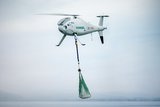Army Leads Defense Department Effort to Coordinate Near-Term Flying of Unmanned Aircraft in National Airspace
The Army Unmanned Aircraft Systems (UAS) Project Office today announced it has created a new directorate to lead one of the Department of Defense (DoD) efforts to solve issues related to flying unmanned aircraft in the national airspace system (NAS) alongside other aircraft.
The Unmanned Systems Airspace Integration Concepts (USAIC) product directorate will develop, test and field a ground-based system that will give UAS operators a sense and avoid capability during flight to provide a mitigation to the inability to comply with Federal Aviation Administration (FAA) “see and avoid” safety regulations. The Federal Aviation Regulation (FAR) for “see and avoid” is Part 91.113 and states, in part, “When weather conditions permit, regardless of whether an operation is conducted under instrument flight rules or visual flight rules, vigilance shall be maintained by each person operating an aircraft so as to see and avoid other aircraft.
When a rule of this section gives another aircraft the right-of-way, the pilot shall give way to that aircraft and may not pass over, under, or ahead of it unless well clear.”
“With the growing demand by battlefield commanders for more UAS platforms to use in combat situations, the military services will require access to more airspace for training, testing and operations,” said Col. Greg Gonzalez, project manager for the Army’s UAS Project Office headquartered at Redstone Arsenal, Ala. “The challenge for DoD now is to find a balance with the FAA to allow that access while maintaining the FAA’s charter to keep the national airspace safe. We are leading the effort to find the solution.”
The increasing demand for UAS on the battlefield is because these systems give commanders eyes in the sky to perform reconnaissance, surveillance, target acquisition and, if necessary, attack, without putting soldiers in harm’s way. Congress directed the research and development of alternate airspace integration solutions in the 2009 National Defense Authorization Act and the Office of the Secretary of Defense, Joint Chiefs of Staff and the services have published documents requesting investigations of such a solution.
Restricted airspace is limited and getting more crowded each year with flight testing by all the services for both manned and unmanned aircraft, increasing the need for access to the NAS. Recent DoD estimates indicate a need for approximately 1.1 million NAS training hours annually by 2013.
“Unmanned aircraft currently are limited to flying in restricted airspace or operating under Certificates of Authorization or Waivers to fly in unrestricted airspace. Those waivers are quite limiting in that they allow only specific UAS platforms to fly, and only during daylight hours and in specific areas, and only with chase planes or ground observers to monitor them,” said Lt. Col. Trey Kelley, USAIC product director. “To continue to give our warfighters the training and tools they need for combat missions, it is becoming critical that the services have access to the NAS.”
The road to accessing national airspace will include development of technologies, starting with a ground-based sense and avoid (GBSAA) system that will provide situational awareness to the UAS operators on the ground and enable them to maneuver an unmanned aircraft away from other air traffic, thus providing a mitigation and/or a alternate means to comply with FAA safety regulations.
The Army’s GBSAA system began as a proof of concept and rapidly became DoD’s best alternative for pursuing a near-term safe solution to flying UAS in the NAS. The USAIC will continue to develop and expand GBSAA concepts as part of DoD’s larger sense and avoid (SAA) solution.
“Developing the solution includes proving safe flight at night, and we anticipate marking that moment in history later this year,” said Kelley.
In addition to developing GBSAA technologies, Kelley and his team are charged with validating the process for using ground based sensors so that it becomes standard and repeatable, develop requirements for any sense and avoid system, and develop the requirements and standards for evaluating and qualifying an SAA system.
More from Uncrewed Vehicles
-
Jammer resistant drone designs spark search for countermeasures
The Russia-Ukraine conflict has driven another stage of evolution for drones and the counter measures to defend against them.
-
![L3Harris launches Amorphous software for control of uncrewed platforms]()
L3Harris launches Amorphous software for control of uncrewed platforms
The new Amorphous software is a universal controller that would allow a single operator to control a swarm of “thousands” of uncrewed systems, from drones to underwater platforms.
-
ideaForge unveils new UAVs at Aero India 2025
India UAV supplier ideaForge has launched the Netra 5 and Switch V2 drones at Aero India 2025, boasting of enhanced endurance, AI-driven autonomy and improved operational capabilities.
-
![Shaping the future of defence: What 2025 holds for the global drone market]()
Shaping the future of defence: What 2025 holds for the global drone market
The UAV market is experiencing unprecedented growth, with innovations in technology and battlefield applications driving demand across military sectors. From the battlefields of Ukraine to NATO exercises and beyond, drones are transforming how wars are fought and supported.
-
![Maris-Tech confirms customers signing up for Jupiter Drones codec and AI-powered system]()
Maris-Tech confirms customers signing up for Jupiter Drones codec and AI-powered system
Launched at AUSA in October, the company’s multi-stream video codec is attempting to bring a new lease of life to drone technology through its AI accelerator.
-
![AUSA 2024: Quantum-Systems targets big 2025 with UAS developments]()
AUSA 2024: Quantum-Systems targets big 2025 with UAS developments
Quantum-Systems has been upgrading its UAS family, with new versions of the Vector, Reliant and Twister drones set for release throughout 2025.
























